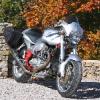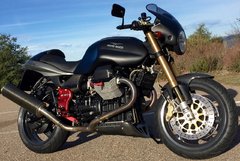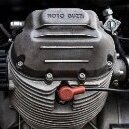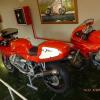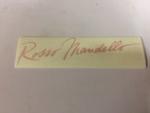Leaderboard
Popular Content
Showing content with the highest reputation on 03/11/2023 in all areas
-
4 points
-
If this happened under extreme braking it is unlikely to be pressure loss due to pick up exposure. The pick up on the 'Broad Sump' motors is at the front on the right of the sump. Under heavy braking the oil will slosh forward and there is little chance of it being exposed. It's on hard acceleration, and especially if you wheelie it, that the pick up is likely to be uncovered. In this case, if I'm interpreting the OP correctly, the light remained on for ten minutes after the event during which time the motor was running and the bike was being ridden. If there had been a catastrophic loss of pressure the crank would be toast. Plain bearings simply can't survive without a constant supply of oil at the correct pressure. We are talking seconds, not minutes for irreparable damage to occur. That leads me to think it is far more likely that the cause for the light coming on is far more likely to be something as simple as a dodgy switch, (A well known and documented issue.) or even simply the connector on the wire that goes to it being loose and just the inertia of the cable hurtling forward as the brakes were applied may of caused it to slip and break the circuit. I'd still suggest the installation of a sloppage sheet as it really is very cheap protection for your crank but in this case I don't think it would of helped.4 points
-
3 points
-
The problem with the sump spacer to crankcase oem gasket blowing out around the oil delivery galleries has been well documented with the CARC 8V engines and it’s been one of Pete Roper’s crusade to have them replaced with available aftermarket thicker gasket as routine maintenance, to prevent it from happening and the consequent loss of oil pressure. These oem metal core gasket recommended by Rolf are new to the 1400 engines and are now spec’d by MG on 1200’s as well. Aftermarket thicker gasket: https://www.mgcycle.com/index.php?main_page=product_info&products_id=34 Oem metal core gasket: https://www.mgcycle.com/index.php?main_page=product_info&products_id=54952 points
-
+1 True, as the oil pressure switch rides ahead of the left cylinder, vulnerable to the weather. IIRC, the connector to the oil pressure switch on the V11 are all just pressed on with no shielding. Worth a careful clean, crimp, seal (Vaseline®). I sourced a switch boot from the EV series for mine . . .2 points
-
In general - a simple paper gasket between 2 very small surfaces where you have a a varm oil pressure, are not the best choise of materials. A reinforced steel gasket is in my oppinion the better solution.2 points
-
I chased a low pressure situation for a while on a 2003 LeMans. Turned out that part of the gasket (as pictured in Rolf's post) was missing. This internal leak allowed oil to escape but maintained low pressure - the light would sometimes come on at idle, but would always go out with a blip of the throttle. It ran like that for a long time without any failure, but I did find excessive wear on the washers on the rocker-arm shafts. The problem with the warning light is that it only tells you about dangerously low pressure. If you care for a lengthly and somewhat philosophical exchange about this issue, see my topic about it at: "Oil Pressure vs. Oil Flow"2 points
-
So I gave it to Piaggio, can't afford the time and money to fight it. Web site is now at http://www.minnaert.net1 point
-
It mainly affects the 8V's and the problem seems to be that the gallery in both block and spacer is larger and the bottom of the gallery in the block has a largish chamfer on it. This means that the actual thickness of the clamping surface for the gasket is very thin. Couple this with the clamping force being applied still by only two 6mm bolts and the shitty quality of the original gasket and it's a recipe for disaster. PS. It has been known to happen n 2V CARC bike engines too, but it's much rarer. I wonder if it became an issue when they went to the trochoidal pump from the gear pump but I'll likely never know.1 point
-
Yeah. It doesn't happen to all of them but it's common enough that Michael and I recommend it to all of our customers who are having their bikes rollerised and inform other people and let them make the choice but we do encourage it. I've had it happen on two of my engines. Both required new big end shells as a result. Many people go essentially the life of the motor with no problems but failures are frequent enough to be a concern. Unfortunately the first symptoms are usually big end knock at idle. If it is allowed to progress from there it can get to the point where the cam chain tensioner plungers aren't getting enough oil to prime and they rattle! By then delivery to the top end must be well marginal and I'd expect there to be further damage to the tappets and cam bearings.1 point
-
Al, thanks for tracking down the stainless steel gaskets from MPH! I had ordered the standard gaskets and was in the process of trying to install them, which hasn't been a lot of fun. I'm going to halt that process and wait for the MPH parts to arrive. It's still awful weather here so it won't mean missing out on any riding to wait.1 point
-
Upper Sump Gasket: Moto Guzzi P/N 01003650 Replacement Part: Moto Guzzi P/N B063861 Difference from original: Metal reinforced gasket as used on 1400 motors. Prevents blowouts of paper gasket that can reduce oil pressure with an internal (hard to detect) oil leak. As suggested by @Rolf Halvorsen1 point
-
Do you have an added oil pressure gauge that shows the pressure, or just the standard oil warning light on the dash? (It sounds like you have just the light or you would have told us the oil pressure in numbers). And do you mean you rode the bike for 10 minutes with the oil pressure warning light on? And if so, did it eventually go out? Assuming your oil level is correct and your filter is still on tight, you might want to test the actual oil pressure with an external gauge.1 point
-
1 point
-
An update from MPH regarding their "Startus Interruptus" kit, specifically for the V11 Sport/Lemans: https://mphcycles.com/starter-relay-fix-kit/ They are currently out of the V11 kit, and need to order relays to build more, but are in the process of doing so if anyone is interested.1 point
-
I think everyone may have missed my edit to my post above which was: So it appears that MPH already makes them1 point
-
No engine heat problem, to far away. Smells more like a Shindengen fix . Cheers Tom.1 point
-
Here's a list of things to inspect, clean or lubricate while the wheels are off for a tire change: (The wheels don't have to be off to do all of these maintenance points, and not all need to be done every time) >Check the wheel bearings for smoothness and play. >Clean and check the brake pads for wear; polish and grease the pin(s) very lightly with a silicone based grease.. >Clean the brake pistons and restore their motion in and out of the calipers evenly. This involves blocking every piston but one and moving it in an out of the caliper all the while cleaning it with brake cleaner. > This good advice from gstallons on brake drag: http://www.v11lemans.com/forums/index.php?showtopic=20133&p=225343 >Bleed brakes, especially the rear brake while you can turn the bleeder to the top. > Clean the fork seals with a "SealMate", or equivalent, including the dust seals. Performing this simple task routinely may extend the life of your fork seals impressively! >Remove the top and bottom rubber caps from the rear brake master cylinder and inspect, clean, and lubricate. Use only silicone based grease around brake parts (under the master cylinder, inside the rubber cap). Make sure there is good electrical connection to the switch at the top and avoid the silicone based lubes (dielectric) on electrics - simple petroleum jelly (Vaseline®, or better: Caig DeOxit Gold®) will keep the moisture out. Grease does not conduct electricity - it's just to keep the moisture out. http://www.v11lemans.com/forums/index.php?showtopic=18158&p=192643 >Clean the rear brake carrier pin and block; lube lightly and be certain the pin threads are clean, lubed* and well torqued. (later V11s have a retaining clip on the inboard side). *Consider a thread locking compound. Allowing this locator pin to fall out can be catastrophic! On the early V11 (1999-2002), some have decided to torque the pin in place and only use the sliding block to remove the rear wheel, perhaps reducing the chance that the pin would not be reinstalled correctly and safely. >Bleed the clutch. >Clean the gearbox vent and the rear drive vent. >Locate, inspect, groom and otherwise secure the wiring and connectors from the Side Stand Switch. This is how your V11 gets electrical power to the Run Switch while you are riding along. Without it, you will not be riding along. Might as well have a close look at your side stand mechanism: pivot bolt, backing nut, springs, and foot "lever"(wire loop). Make certain the sidestand bracket fasteners are secure to the timing chest and sump spacer. The main, large fastener here is torqued to 70-75 Nm! Loose fasteners here could contribute to a broken sump spacer. (no need to have the wheels off for this one!) >Inspect the rear exhaust crossover hanger and both of the canister/passenger peg subframe supports. >Clean the wheels and rotor carriers ("float buttons") and lube the front carrier buttons (a drop of Breakfree CLP (or equivalent) works well, but don't let it sling out on the rotor surface. Bumping the rotors around with a mallet helps keep them “floating.” Even out the spacing of the rotor on the carrier by tapping evenly around the perimeter of the rotor with a soft mallet. >Check the torque reaction rod (chassis rod) rubber bushings for deterioration and play. With the rear drive removed and driveshaft separated, service the pivot bolts . Clean the pivot bolts and apply something reliable for corrosion resistance, especially the front pivot that has been reported to break. >Check the rear drive bearings; clean and grease the outboard needle cage and its sleeve with a good waterproof grease insuring that you rotate it to a new position. Here is an excellent thread, by Bjorn, with lots of great pictures of this bearing, the swingarm, and the bevel box internals. [edit 26 April 2018: It has come to light that keeping moisture out of the right side needle bearing protects the "nose" of the crown wheel and the inner drive seal. Once pitted, the crown wheel is difficult to restore.) >Clean and grease the drive splines for the hub. Use something super-sticky, like Klüber Staburags or a dry-film moly coat. Avoid over-greasing (it will just sling off). >Lube the driveshaft and its U-joints. Don't put too much grease in the splined connection or it will trap air and not go back together. Before you take the two halves apart, make sure there are clear alignment marks. Consider verifying the Driveshaft Phasing. >Carefully inspect the driveshaft yokes for signs of looseness, fatigue or cracking. Verify the pinch bolts are torqued and the the yoke collars do not slide on the output or input shafts. >Inspect the shock eye connection to the swingarm. The early V11 white spring/blue collar Sachs-Böge are prone to crack. Grease the pivot bolt and junction of the steel bushing and alloy shock eye! >Service the cush drive. The button head screws will not likely come out willingly, so expect a fight (heat and penetrating oil/solvent) and replace with new fasteners. >Clean and lubricate all the fasteners. I use a small wire brush and anti-seize paste. >Inspect, clean and seal the main ground(earth) cable to the back of the gearbox. You have to remove the seat latch release to get to it. If you find the cable is not directly to the gearbox, move it there, but be careful if you remove the bolt entirely as there has been a report by SeanP61that it might not just go right back in. > Mounting the front of the battery carrier basket beneath the subframe adds considerable clearance for the battery under the seat pan. The front tabs of the basket must be slightly contoured to fit between the frame tubes. > Remove, clean, lubricate, adjust, and shim (if necessary) the foot shift lever and mechanism. They get sloppy, loose, crudded-up, and misaligned. So much better with no play, sticking, or striking the frame side plate on the down stroke. > Clean and lubricate the sidestand mechanism; inspect and secure the wiring to the switch; tighten the vulnerable lower bolt (circled in red) and torque the important upper mounting bolt (70-75 Nm!) [edit 22 March 2021]1 point
-
What with the surprising results I got from simply cleaning my leaking fork seals, I added this to The Checklist . . . [edit June 2022: This lasted 5,000 miles/ 8.000 km before having to repeat. Surprisingly good outcome!]1 point
-
I've beat this next drum before, but here it comes again. On our V11, the outboard needle cage and its inner race get neglected. It is trapped in the "nose" of the reardrive next the the right arm of the swingarm. It only rotates the arc of movement of the swingarm and does not "spin." Since it not exposed when the wheel is pulled, say for a tire change or brake service, it often goes unseen until it gets ugly. If moisture and wetness and nastiness is allowed to enter there (and it will), this will ruin the sealing on the crown wheel of your reardrive. Read: Very Bad. Anytime the rear wheel comes off, for whatever reason, pull the axle far enough to service this critical part! Clean and liberally grease with waterproof grease (the needle cage, inner race, and cap washer). Every time. Here is some more support for this encouragement: L->R / lower row: > 50,000 mile unserviced/ruined race from a northern US state that ruined the reardrive. > 14,000 mile from coastal California, USA, that was rusted along with the needle cage. Even polished up with 600 grit, damage remains. > My original 111,000 mile race with obvious indentations from the needles. > New (and surprisingly smooth and shiny!) inner race. Grease that outboard reardrive junction with your swingarms, please!1 point
-
1 point
-
1 point
-
I'm going to take them off, along with the valve covers and the alternator cover, and repaint the lot of 'em so that they match. I wonder if someone who has done this before would be so kind as to provide some advice and guidance, things to watch out for, always or never do, etc., etc., please? Yes, I've searched and looked through the site, and there are lots of threads. Some say it's so difficult that one should just mask it all off and paint in place, others say it's a piece of cake so long as you line everything up. And there was something about 8' fluorescent light bulbs, a girl named Ginger, and a bottle of Tequila, too, I think. Thanks in advance, C1 point
-
The bearing is 6204 sealed bearing with dimensions of 20x47x14 NAPA part number is 6204-2RSJ SKF 6204-2RSI or SKF 6204-2RSH or SKF 6204-2RSL The SKF 6204-2RSL is for lower friction The SKF 6204-2RS is for better seal The SKF 6204-2RSI may be outdated, but is probably most common. I think the NAPA is an SKF 6204-2RSI Anybody know how to get the bearing out???1 point

